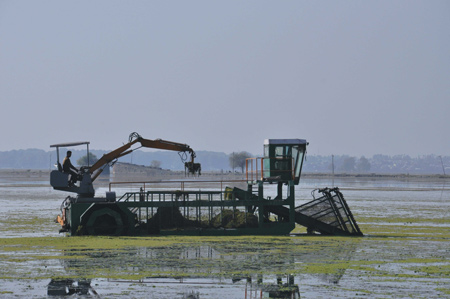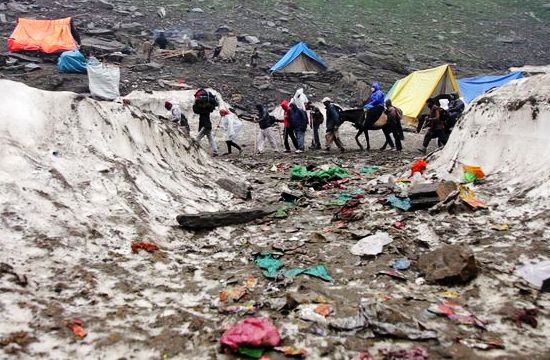The government has introduced deweeding machines to remove obnoxious weeds which are threatening the ecosystem of lakes in Srinagar. As UMAR FAROOQ finds out, the machines have only compounded the problem but have also disturbed the aquatic life in these lakes.

In 2010, when the new dredging machines were imported to remove the obnoxious quantity of weeds from Dal Lake, Chief Minister Omar Abdullah had expressed hope that they would make a concrete change to restore the Dal Lake to its original glory. However, the dredging machines, which were seen as a boon for the ecosystem of Dal Lake have become a threat to the flora and fauna in the lake.
Near the Nigeen club at Gath No 1, a long cue of shikaras ferry tourists to their houseboats. There is no break in the flow of tourists visiting the lake. “Most tourists approach this place to stay in houseboats” says Javeed, a local shikarawalla. As Shikaras moves from one place to ferry the tourists to the houseboats, the weeds in the waters of the lake are clearly visible.
“This is stinging to eyes, very unclean! It leaves a bad impression on tourists and customers”, says Javeed, pointing towards the lake. The other Gaths at Ashaibagh and Sadrabal are not only visibly repulsive but also stink.
However, beyond this, there is something more serious happening at Nigeen. “The job of the deweeder is to clean the lake. It has to carry remove the weeds, not to kill the fish,” says Javeed.
According to a source, on an average, the deweeder leaves as many as 5000 fishes dead in a day. This rate could be considered alarming if the figures are calculated for a year. Operated by a single driver, the huge deweeder consists of a cutting blade close to the driver seat. When the blade of machine starts, the weed gets chopped and is collected on the trolley of machine.
There is a dangerous sight. The fish are found swimming in the chopped weed and when the trolley carries the weed up, a number of fish get trapped, which are carried up alive in the machine where they die.
“This machine is of no benefit. It simply chops the weed at the top. It leads to increase in growth of weed because it doesn’t pull out weed from its root as it happened when they used spikes. It only cleans the lake peripherally”, says Javeed.
According to environmental science expert, Prof. G.A Bhat, manual cleaning of lake would be a costly affair besides involving lot of time and labour. “The basic question is why we are using de-weeding machines. Why is the weed in the lake beyond proportion? There are many reasons for it like tourist influx, improper drainage system, urbanization; development and housing, which are taking place on lager proportions. Furthermore, waste in the houseboats and adjoining areas of lake goes directly or indirectly in the lake. We can’t do much about it,” he says.
However, the other mechanisms that were put in place to clean the lake are simply unable to do so. With the result this has increased the amount of weed in the lake beyond proportion. “The basic reason for increasing growth of weeds in lake is that the sewerage water is not treated properly in sewerage treatment plants which should at least clean the water up to 80-90 per cent. But ironically, only 30-40 per cent of water is treated and the rest goes untreated into the lake. Besides this, the amount of flushing that used to happen earlier doesn’t happen now due to lesser rains and snow. With the result, most of the waste is absorbed in the lake”, says Prof. Bhat.
On the other hand locals believe that deweeding machine which was earlier seen as a way out for all problems, have given rise to new problems. “The most important aspect of lake conservation is to take care of the quality of its water along with the aquatic life living therein. One would not like the lake to be restored as a dead lake without any aquatic or plant life. Moreover, this machine only cleans the lake superficially and it takes no time for weed to grow up again”, says Farooq Ahmad, a local at Nigeen.
Prof. Bhat believes that the lake will not remain a natural eco-system. At most, it may remain semi-natural ecosystem at most in the near future. However, the authorities might have to continue the use of deweeding machines to maintain lakes as very less options are available. “Nevertheless, I believe removing weeds manually would be better than using deweeders. However, cleaning the whole lake manually is not possible. But the positive thing using spike was that the aquatic life was not disturbed, it was not leaving the fish dead. Further, deweeding machine is not the solution. It is not the sustainable way to clean the lake”, he says.














